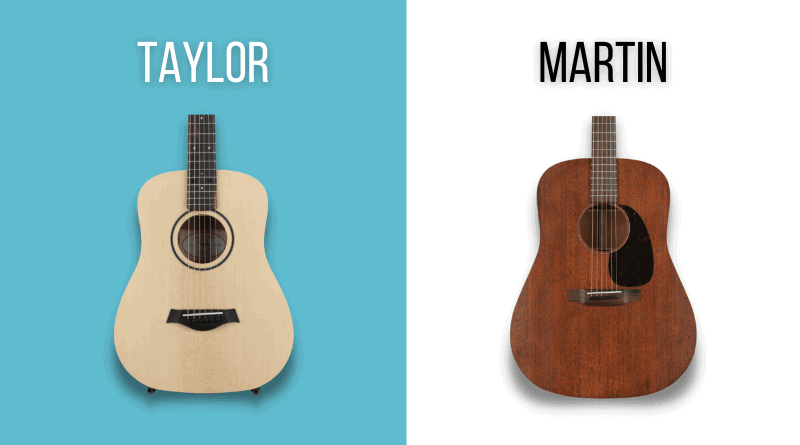When it comes to acoustic guitars, the two biggest names in the business are without a doubt Taylor and Martin. Martin has been producing some of the world’s finest stringed instruments since 1833, so their reputation in the industry goes without saying. Taylor, on the other hand, has enjoyed a rapid rise to prominence since their brand was formed far more recently, in 1974.
So, how is it that these two brands have come to be such fierce competitors given the significant difference in history? In this KillerGuitarRigs Guide, we’ll be taking a deep dive into these two companies to find out the differences between the brands, and the guitars that each brand manufactures.
If you’re in the market for an acoustic guitar, and you can’t quite decide between a Taylor or a Martin, you won’t want to miss this!
Contents
- Taylor vs. Martin Quick Comparison
- The History of Taylor and Martin Guitars
- Pros and Cons of Taylor and Martin Guitars
- Tonal Differences Between Taylor and Martin
- Taylor and Martin Build Quality
- Martin Guitars Materials and Craftsmanship
- Pricing
- Famous Players and Signature Models
- Final Thoughts on Taylor vs. Martin
Taylor vs. Martin Quick Comparison
The main differences between Taylor vs Martin guitars are:
- Taylor Guitars are well known for their very bright tone out of the box. Martin guitars, on the other hand, typically have a slightly darker and richer sound.
- The majority of Taylor Guitars are made with a 15-inch fretboard radius, whereas Martin guitars usually have a 16-inch fretboard radius.
- Many Taylor guitars are built with an innovative V bracing technique, while the majority of Martin models are still made with a more traditional X bracing pattern.
- Taylor Guitars is a much newer company, having been founded in 1974, while Martin is actually one of the longest continuously running brands, producing acoustic guitars since 1833.
The History of Taylor and Martin Guitars
Both Taylor and Martin are storied brands and, while their histories are quite different, both have emerged as some of the premier guitar-builders of the modern age.
History of Taylor Guitars

Taylor Guitars was founded in 1974 by Bob Taylor and Kurt Listug, two friends who worked at a guitar sales and repair store known as American Dream Guitars. Taylor is now headquartered in El Cajon, California, and in a relatively short span of time managed to gain an incredible reputation for great-sounding (and looking) guitars.
Ever since the beginning, Bob Taylor and Kurt Listug built guitars from scratch, including the bracing, tops, and necks. They used innovative designs and construction techniques, all designed to increase the stability of the guitar and improve its tone.
In the 1980s, Taylor Guitars introduced the Grand Auditorium, which was a completely new body style. This is the shape the brand has become best known for thanks to its versatility and beautifully balanced tone.
Since then, Taylor has continued to innovate, coming up with models like the T5 – an incredible hybrid acoustic/electric guitar – and the Baby Taylor, a reduced-size guitar designed for travelers, beginners, and younger players.
Until recently, Taylor and Listug were still heavily involved with the company, with Listug serving as CEO all the way until 2021, when the role was passed on to the company’s (former) Master Guitar Designer, Andy Powers. At that time, the company actually became 100% employee-owned, which is yet another example of the brand’s commitment to innovation and desire to ensure longevity.
History of Martin Guitars
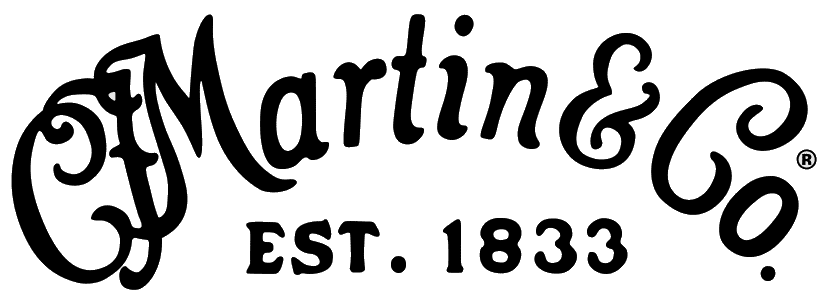
Martin guitars is a world-renowned guitar manufacturer, established in 1833 in New York by German immigrant Christian Frederick Martin. The company eventually moved to Nazareth, Pennsylvania, where they remain today in their historic factory.
The early years of Martin & Co. were dedicated to building guitars that were different from those made in Europe at the time. Christian Martin, who had originally trained under traditionalist Viennese luthiers, designed and used a new X pattern bracing system that improved resonance, volume, and sustain, and also made the guitar more reliable and durable. Most importantly, this improved stability allowed Martin to install steel strings on their guitars, a truly game-changing feature.
Another of Martin’s most significant inventions was the dreadnought body shape. This design was unveiled in 1913 and went on to become one of the most popular acoustic guitar styles in history.
Martin’s extensive history and excellent reputation for quality meant that some of the biggest names in the world wanted to be seen with their instruments, with the likes of Elvis Presley, Johnny Cash, and Bob Dylan all counted as Martin players for at least part of their careers.
Today, the company is still owned and operated by the Martin family and has expanded to produce an extensive range of guitars, both in the USA and in their Mexican plant.
Pros and Cons of Taylor and Martin Guitars
Taylor and Martin both make exceptional guitars, but of course, they aren’t without their drawbacks. Below we highlight some of the more common pros and cons of both Taylor and Martin.
Taylor Guitars Pros and Cons:
- High end construction: Taylor Guitars are known for their excellent build quality and attention to detail
- Innovative features: Taylor Guitars is known for incorporating innovative features and technology into their instruments, such as their proprietary Expression System electronics.
- Wide range of models: Taylor offers a wide range of models to suit a variety of playing styles and preferences, from travel sized guitars to dreadnoughts and jumbos.
- Bolt on necks: While Taylor’s bolt on necks are extremely innovative, many players are stuck on the idea that set and glued necks are superior, even if it’s just from a craftsmanship perspective.
- Bright tone: Taylor guitars have a reputation for being too bright out of the box. Of course this might be subjective, but It’s a well documented trait of the brand.
Martin Guitars Pros and Cons:
- Superb quality: Martin has a strong reputation for exceptional build quality and use of premium materials.
- Iconic sound: Martin guitars have a unique tone that is instantly recognizable.
- Excellent residual value: Martin’s guitars tend to hold their value extremely well, and in some cases, models may even appreciate, and become more valuable over time.
- Premium pricing: Even basic Martin models are quite expensive, and you may be able to get more features from other brands for the same or less money.
- Traditionalist Brand: While Martin Guitars are known for their high quality construction and great tones, their commitment to traditional construction techniques means that brands like Taylor have left them behind in terms of technology.
Tonal Differences Between Taylor and Martin
The unique way in which each brand makes their guitars, as well as how they choose and age their woods, has a big impact on the tone of the finished product. Even with an apples-to-apples comparison using the same body style from each brand, the tonal differences can be significant.
Taylor Guitars Tone and Sound
Taylor Guitars are known for their bright, clear tone and excellent projection. They tend to have a more modern sound than the majority of acoustic guitar brands, delivering tight focus and great clarity and definition.
One of the key features setting Taylor Guitars apart from other brands is their use of their in-house Expression System pickups. These allow for a natural and accurate recreation of the organic acoustic tone when amplified, and are engineered specifically to sound great with Taylor guitars.
In terms of tonal quality, Taylor Guitars generally have a balanced output with a strong midrange and plenty of top end (when new). They have great note separation, too, with incredible articulation.
In general, the sound quality of a Taylor Guitar will depend on the specific model you opt for. A high-end, all solid-wood model like an 814ce will sound amazing out of the box and continue to get better with time as the wood matures. Whereas a budget model like a Baby Taylor will sound great out of the box, but likely won’t develop tonally.
Martin Guitars Tone and Sound
If you’re looking for a classic tone with tons of warmth and richness, you’ll want to look at Martin. They’re known for their balanced tone that leans just a little towards the darker side in the mid range. This makes them great for pretty much any genre or playing style, but blues, folk, and country is where they really shine.
Martin partnered with Fishman to provide the electronics for the majority of their acoustic electric models. While they’re a great match, these electronics aren’t engineered exclusively for Martin. Regardless, they still do a great job of preserving the natural acoustic tone when amplified.
Despite their full-bodied sound, Martin guitars also offer strong clarity and articulation, allowing individual notes to be heard clearly and distinctly, even in a busy mix. This is one of the big draws to Martin for many players.
As well as having excellent note separation, Martin guitars are well known for their fantastic projection and cannon-like volume. This reduces the need to strum too hard or pick too aggressively, which helps enormously with the clarity and articulation.
Which Sounds Best – Taylor or Martin?
Determining whether Martin or Taylor has better sound quality is totally subjective and ultimately comes down to personal preference. While Taylor Guitars are known for their bright sound and bell-like clarity, Martin Guitars are prized for their tonal depth and superb articulation.
Ultimately, both brands produce high-end instruments with excellent sound quality, and you can’t really go far wrong with either.
If you’re trying Taylor or Martin acoustics out at a store, it’s important to remember the sound quality of an acoustic guitar can be influenced by a number of factors, chief among them the environment in which the guitar is being played. With this in mind, be sure to try both brands in the same location to get the most realistic comparison.
Taylor and Martin Build Quality
We’ve mentioned several times throughout this guide that both Taylor and Martin are well known for making quality guitars using the best woods and components around. Both brands employ builders and luthiers with varying degrees of skill and expertise, and this is often reflected in the pricing of the respective models.
Taylor Guitars Materials and Craftsmanship

Taylor employs a rigorous QA process to ensure that every guitar leaves the factory in a condition that reflects the values of the brand. Their entry to mid-tier models are all made in their Mexican plant, which geographically speaking, is less than 40 miles from their flagship California factory.
They use high quality tonewoods in their construction, including Sitka spruce, rosewood, and ebony. They also use innovative construction techniques, such as their patented NT neck design, which provides greater stability and sustain.
A notable feature of Taylor construction is the use of ebony fretboards, even on their cheapest models. Additionally, every single Taylor guitar has a solid wood top, with many models also benefiting from solid back and sides.
In terms of craftsmanship, Taylor Guitars are built using a combination of old-world craftsmanship and cutting edge manufacturing technology. Each guitar is hand-finished and inspected for quality, ensuring that only the best examples find their way into the hands of customers.
Martin Guitars Materials and Craftsmanship
As mentioned, Martin is probably most famous for the fact that they have been continuously building some of the best guitars in the world for almost 200 years. Martin also uses a Mexico-based factory to produce their entry to mid-level models, but their premium guitars are built in Nazareth, PA.
Martin Guitars, like Taylor, is known for their use of high-end woods, although unlike Taylor, they use more traditional construction techniques, such as scalloped bracing and dovetail neck joints.
Interestingly, for a company that prides itself on its heritage and traditional craftsmanship, Martin does tend to use more in the way of artificial materials and laminates, especially on their lower and mid-tier models. The use of HPL is prevalent on fretboards, Richlite is quite common for guitar necks, and several of the Little Martin series models make use of laminate tops as well.
Despite using some non-natural materials on their entry-level models, Martin guitars are designed and built to last, and will give their owners decades of enjoyment with the proper care and attention.
Does Martin or Taylor Have Better Build Quality?
It’s tough to say which of these two powerhouse brands has better build quality. You could argue that Taylor uses better materials and components as every model has a solid top and even entry-level guitars get an ebony fretboard. On the other hand, you could say that the craftsmanship of a Martin is superior because of the dovetail neck joint vs the bolt-on neck of a Taylor.
Some players may prefer the traditional construction techniques used by Martin, while others might appreciate the innovative approach of Taylor. Ultimately, the best way to determine which has better build quality is to play both brands and see which one feels and sounds better to you.
Pricing
As Taylor and Martin are such close competitors, each tends to price its models to either match, or come very close to the other brand’s equivalent models.
Taylor Price Points and Models
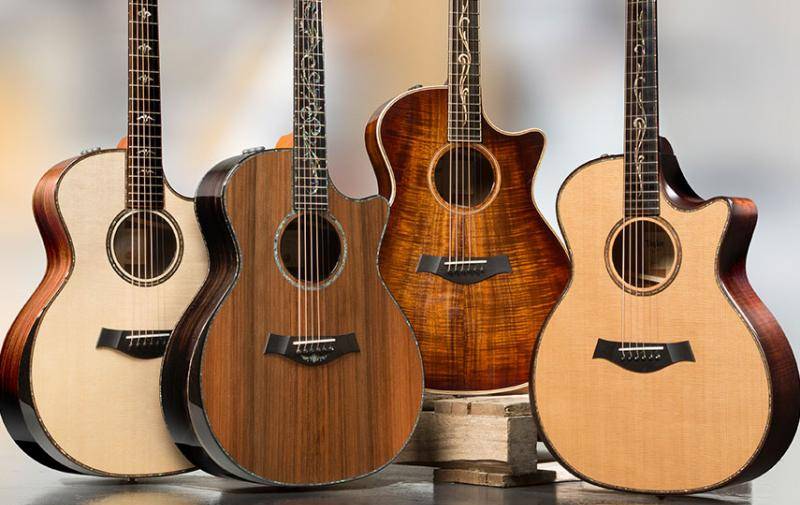
Taylor Guitars offers a wide range of models at different price points, from entry-level guitars to high-end custom instruments. Some of the most popular Taylor models include the Baby Taylor, the GS Mini, and the 814ce.
The Baby Taylor BT1 is the most affordable model in the Taylor lineup. It’s a reduced-size guitar priced at around $399. The GS Mini, which is one of the most popular models Taylor makes, is priced between $599 and $1199, depending on spec. Both the BT1 and GS Mini are Mexico-made models.
The American Dream AD27 is Taylor’s most affordable US-made model and comes in at approximately $1,499. One of their most popular models, the 814ce sits around the mid-tier of their US-made guitars and costs around $3,999. Taylor’s flagship guitar is the sublime Taylor PS14ce. It’s a stunning collector grade instrument that comes in at $9,999.
Martin Price Points and Models
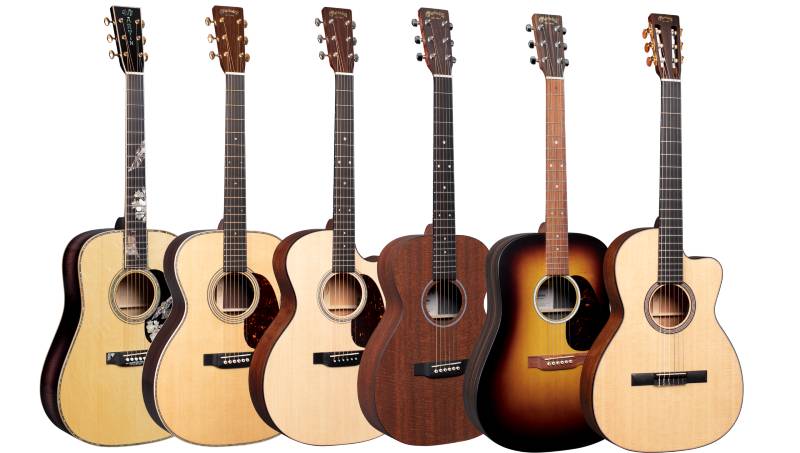
Martin’s lineup is also extremely varied and features guitars to suit all budgets. They make everything from travel guitars like the Martin Backpacker and Little Martin series, through to workhorses like the D-15M, and luxurious pro grade models like the D-45.
The Martin Backpacker is an unusual guitar designed specifically for travel. With a $299 price tag, it represents the most affordable way to get a new Martin guitar. Their Little Martin series, which has famously been endorsed by Ed Sheeran, is another great way to get into the Martin family. The Little Martin LX1 starts at $399.
Their D-15M is an all-mahogany beauty, and is the lowest priced US-made Martin currently for sale, with a price tag of $1,499. At the top end of the Martin range is the legendary D-45, one of the most iconic acoustic guitars ever made. With a price tag of $10,499, it’s aimed at serious players and collectors, but when you hear one, you’ll realize it’s worth every penny.
Is Taylor or Martin Better Value for Money?
As you can see, both brands have priced their entry-level models and their flagships to compete with one another. With that in mind, determining which brand offers better value for money is once again quite subjective. We like to think that the value that any guitar brings is proportionate to the use and enjoyment you get out of it.
Famous Players and Signature Models
Of course, with both brands being as famous and popular as they are, each has a following not just with the general public, but also with some of the biggest names in the business.
Famous Taylor Players
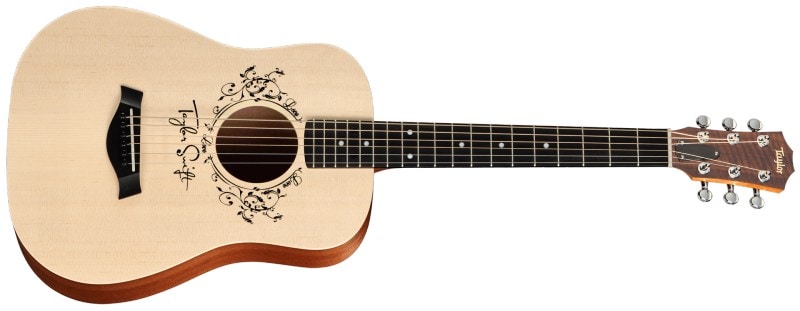
Taylor has established a strong brand presence in the music industry thanks to the high profile players who use their guitars, whether endorsed or not. Some of the more famous artists to have played Taylor Guitars over the years include Dave Matthews, Jason Mraz, Taylor Swift, and Zac Brown to name but a few. These partnerships have helped to further establish Taylor as a leader in the guitar industry and have contributed in a big way to its strong brand reputation.
Does Taylor Make Signature Models?
Taylor currently has just 2 signature models in their lineup, the Jason Mraz Signature, which is a nylon-strung guitar, and the Taylor Swift Baby Taylor. There have been other signature models in the past and knowing Taylor like we do, there’s a good chance there will be more in the future.
Famous Martin Players

With a history as long as Martin’s, it’s no wonder that so many guitar luminaries have chosen to play the Nazareth brand’s instruments. Some of the artists who have played Martin Guitars over the years include John Mayer, Ed Sheeran, and Johnny Cash. These are some seriously heavy-hitting names, and while the brand’s reputation is strong enough to stand up on its own, seeing that such influential players made music with Martin guitars is definitely a great way to encourage newer players to try them out.
Does Martin Make Signature Models?
Martin Guitars has a quite extensive range of signature models in their current lineup, including guitars endorsed by Eric Clapton, Brooke Ligertwood, John Mayer, Shawn Mendes, as well as a special-edition endorsed by the late Johnny Cash.
Final Thoughts on Taylor vs. Martin
At the end of the day, it’s difficult to say which brand is better. There are some areas in which you could objectively say one brand has an edge over the other, but where one brand edges ahead, the other picks up the slack in another area.
With that in mind, if you’re trying to choose between a Taylor or a Martin, you’ll want to think about the tangible differences. If you prefer a bright, clear sound and innovative features, Taylor may be the better choice for you. On the other hand, if you prefer a slightly darker tone and a more traditional approach to lutherie, Martin is likely the brand for you.
If you’re still not sure, we really do encourage you to get out to your local music store and where possible try out both brands. You’ll be able to get a proper sense of the feel and playability that each offers, and you’ll be able to hear the tonal differences for yourself. Once you’ve figured out which you prefer, it’ll be much easier to do some research and find the best prices online before buying!

